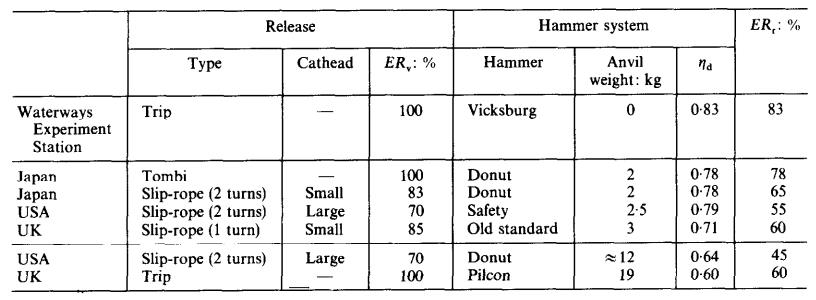|
Equipment |

|

|
This window may be used to select an instrument in the list of the ones in the database, review its characteristics, add those of a new one or remove an existing one. The window may be reached from the Home > General Data menu of. Click on one equipment from the list to select it for use or for editing.
To delete an instrument, right click the name. This enables the Delete function.
To add a new instrument, right click the root (Equipment at the top of the list). This enables the New function that opens a blank window in which the new characteristics may be entered. The characteristics to be entered, usually provided by the supplier, are:
Type |
Equipment Name. |
Step (cm): |
Cone penetration distance increment in cm (10/20/30). |
Hammer weight (Kg) |
Weight of the hammer in kg. |
Flight (cm): |
Length of hammer flight in cm. |
Tip area (cm²) |
Area of cone tip in cm². |
Rod length (m) |
Select from drop down list the length of rods used. |
Rod weight (Kg) |
Weight of rod in kg per meter length. |
Passive mass (Kg) |
Combined mass of hammer port and strike head in kg. (Mass excluding hammer). |
Depth first rod joint (m) |
Depth of first rod joint with the next one in m. |
Specific blow energy (Kg/cm²) |
Is calculated by the program as data of new equipment is entered. |
Correlation Coeff. with Nspt |
Coefficient of correlation with standard test. This varies with effective depth. Usually is used that of second meter. Select from drop down list lower down in the window. |
Coating/Slurries |
Select Yes/No. |
Drilling system efficiency
Standardization of NSPT
The different equipment types introduce variability factors in the value of NSPT therefore is needed a correction to report the number of blows N to the energy efficiency of the driving system. Generally all researchers refer to an efficiency of 60% (N60).
The efficiency of the device is identified as follows:
ERi = (Ei/E*) in %
where:
Ei = Energy of the first compression wave produced by the impact of the hammer it is a loss of energy due to the transformation of the kinetic energy of the hammer into compression wave in the rods.
E* = Nominal kinetic energy of a hammer (free-fall energy of the hammer) of mass/weight equal to 63.5 kg in free fall from a height of 0.76 m (equal to 474 Joule).
The value of Ei is obtained, among many theories, even with the method of the compression wave integration. (F. Cestari, par. 5.3.8.5 – “Prove Geotecniche in Sito”).
Skempton (1986) summarized the values obtained with the most commonly used devices in the world, getting the efficiency ERi as a product of two terms:
ERi = ERv ´ hd
where:
ERv = velocity energy ratio equal to Eh/E* with Eh hammer (transferable) energy in base of hammer impact velocity and hd dynamic efficiency that depends on the dimensions of the hammer, driving system and rods.
In the table below are shown the results of a series of measurements:

Energy ratios and dynamic efficiency
(Skempton, A.W. (1986) – Géotechnique 36, No. 3, 425 - 447)
Correlation coefficient assigned
Check if the user wants to use a correlation coefficient different from the one automatically calculated by the program.
N.B. The program calculates the energy ratio (Coefficient of correlation with NSPT) by methods proposed by Pasqualini 1983 - Meyerhof 1956 - Desai 1968 - Borowczyk - Frankowsky 1981.
Note: For the equipment DPSH TG 63 200 MEARDI PAGANI (with 73 kg hammer) have been made a series of tests to determine experimentally the correlation coefficient, according to which the coefficient 1.66 is certainly applicable to the gravel and gravel with sand and you get to 2. On average it was set at 1.8.
© GeoStru Software